
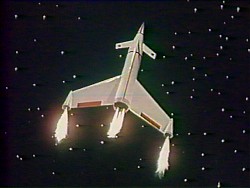
 |
INTERSTELLAR TRAVELLERS! |  |
One of the most familiar myths of the 20th Century is that our earth is now being visited by creatures and vehicles from other planets. This myth has survived since the late 1940s, almost intact, despite decades of detailed exploration of our solar system by manned and by robot spacecraft, exploration which has revealed unmistakably that no planet or moon in our solar system other than the earth itself harbors life in any readily visible form... certainly no life able to build spacecraft and pay a return visit to us. This myth has also survived despite the fact that no evidence whatsoever has turned up, on earth itself, that the earth is now being visited from elsewhere, or has been visited at any accessible time in the past. Indeed, precisely the reverse is true: the myth is so powerful that almost any event, no matter how commonplace, is transformed into this missing evidence. A man lighting his pipe under a streetlamp has been reported as a landing alien space craft— and so has a single cigarette thrown from a car window! Windblown paper and trash, aircraft landing lights, advertising planes, the familiar stars and planets themselves, even the sun and moon, have been reported as flying or hovering alien spacecraft. Hoaxes and frauds and highly suspect claims abound, all tending to prop up the myth. If tens of thousands claim to have seen lights in the sky they “could not identify,” and thus are obviously alien spacecraft, thousands go beyond this to claim that they saw the spacecraft land, often interacted with the crew, and sometimes got taken for rides! No two eyewitness sightings agree, even vaguely, either as to the size and shape of the “spacecraft,” or the size, shape, form and aspect of its crew!
Flying saucer and UFO photos have been plentiful since about 1950 when Paul Trent took a still-much-reprinted shot of a pieplate hovering over his back yard. There are today whole websites devoted to UFO photos— and a quick scan will generally reveal no two alike. In this era, when most people have Adobe Photoshop on their home computers, a “photo” is about the most meaningless “evidence” imaginable. But UFO and saucer photos always have been of no significance— to understand why, go into any room that has been occupied for a while. Note the jar lids, bottle caps, coasters, ashtrays, can lids, frisbees, toys, CDs and DVDs, small plates and bowls of plastic and aluminum foil. Wander out into the garage, and note the light fixtures and lamps and trashcan lids and hub caps and pulleys and odds and ends... anything disk shaped, spherical, cylindrical, triangular... just about anything that is not easy to identify in silhouette or isolation will work just fine. Since about 1982 my students in Physics 341 have taken UFO photos as part of homework assignment 3. I have seen many far better photos from the students, over the years, than have ever been published in books and magazines, or posted on the Web.
Leaving aside the myth and its power and the secret of its appeal for the moment, let's look at the universe we actually do inhabit, and see just how unlikely the idea we are being asked to take seriously is. This is the idea that the earth suffers from frequent, apparently more than daily, visits by spacecraft and crews, all humanoid and obviously from hundreds of different earthlike planets, representing hundreds of different extraterrestrial civilizations. We know that another solar system is the only possible point of origin for such an alien spacecraft, given the presence of only one earthlike planet in our own solar system. Our galaxy contains about 100 billion stars, but the majority are members of multiple-star systems, where earthlike planets would be virtually impossible. As far as we know at present, the probability of a given star having at least one earthlike planet is no more than about 0.6%. [See references below.] Thus we might have about 600 million vaguely earthlike planets in our galaxy, with the average distance between nearest neighbors being 25 to 30 light years, here on the outskirts of the galaxy where we are. [Recent results (2011) from the Kepler Space Telescope and dedicated earth-based telescopes have modified these figures a bit. First, the discovery that our galaxy is a barred spiral rather than a regular spiral suggests it may contain up to 300 billion stars. Second, results from the Kepler Space Telescope and ground-based telescopes currently indicate that probably half of all stars have planets, and probably 0.5% of all stars have rocky planets at such a distance that they could have liquid water on the surface! There might therefore be 1,500,000,000 approximately earthlike planets in our galaxy alone!! The total number of planets is apparently roughly equal to the total number of stars in the galaxy.]
Now we have to make some wild surmises about the probability that life develops on a given earthlike planet, and evolves in rough parallel to life on our own planet, step by step over billions of years, to the stage of intelligence, to the stage of civilization, to the stage of high technology, and finally to a hypothetical stage of constraint-free technology in which the civilization is willing and able to commit almost unlimited resources in time, effort, and energy to enormous projects such as interstellar travel... and then really does decide to travel.
Consider how many turning points and branch points and blind alleys life on earth must have taken over 4.6 billion years! For all we know, the evolution of vertebrate animals, for instance, was overwhelmingly unlikely and only one in a trillion planets with life has vertebrates! We have no way to assign, no possible basis for assigning, a number for the probability of an earthlike planet developing a civilization willing and able to undertake interstellar travel. We do not know of even one case! We'll just make up a number: one in one million. If you want to put it at one in one trillion trillion, I won't argue. If you want to put it at zero, I won't argue. Whatever it is, it is a very, very small number. Now, if we use a number that is probably ridiculously inflated in favor of a given hypothesis, and our hypothesis still turns out to be preposterously implausible, we've certainly learned something! So, using one in one million, we get about 600 earthlike planets with supercivilizations, existing at various times in our galaxy, with nearest neighbors separated, over most of the galaxy, by distances of 2,500 to 3000 light years in space and perhaps millions or billions of years in time. Since stars that are most likely to have earthlike planets remain on the Main Sequence for 10 billion years or more, and the stars of the galaxy have widely differing ages, with solar systems forming all the time, the chance that any two super-civilizations anywhere in the galaxy would be star travelling at the same time is impossibly remote.
If we look specifically at the 100 stars nearest our sun, only about 13% have even the remotest possibility of having earthlike planets. The typical distance to any one of these 13 stars is around 20 light years. If we use our made-up one in a million figure, the probability that one of these stars has a planet which at some time had or will have a star-travelling technology is about 1 in 100,000. One of the great scientific achievements of 2003 was the very accurate determination of the age of the universe as 13.7 billion years, made possible by direct observations of the “big flash,” the moment when the universe first became transparent to visible light, by the Wilkinson Microwave Anisotropy Probe (WMAP). Our galaxy is considerably younger than the oldest galaxies to form. If our own galaxy is about 12 billion years old, the probability that such a a planet has a star-travelling technology now is something like 60 years (roughly the period over which flying saucers have been reported) divided by 12 billion years minus 4.6 billion years (roughly the time to develop such a civilization), or roughly one chance in 125 million. This figure cannot be taken too seriously, but it definitely gives food for thought!
We now turn to the problem of getting from one star to another. We will ignore the enormous investment of energy required for interstellar travel, and focus on the time required, as determined by basic physical law. Details of technology are unimportant (and also nebulous). One of the four fundamental forces of nature must be involved in propulsion. Of these, gravity and the weak nuclear force are too feeble to be usable. This leaves us only with the electromagnetic force or the strong nuclear force. An example of electromagnetic propulsion would be a rocket that burns chemical fuel in oxygen. An example of nuclear propulsion would be a rocket that uses heat from a nuclear reactor to ionize fuel, and electricity from the same reactor to accelerate the ions to high speeds. Technology doesn't matter at all, since speed limitations arise from basic physical law. The ratio of the final speed v of a one-stage rocket to the speed of light, c, is very roughly v/c = square root of 2f, where f is a very small fraction specified once one states which fundamental force of nature is utilized by the propulsion system. For chemical (electromagnetic) processes, f is roughly 10-10. For nuclear processes, it is roughly 10-3. Thus the ultimate speed, using the strongest known force, is about 10 million meters per second. One could, of course, double or triple this speed by using a multistage rocket, but factors of 2 need not concern us here! A speed of 107 meters per second, or 6000 miles per second, may sound pretty fine, but at such a speed it would take about 500 years to cover a modest interstellar distance of 20 light years, and nearly 100,000 years to cover 2,500 to 3,000 light years— our crudely estimated distance to the nearest solar system which might have had a civilization comparable to our own at some time in its history, not necessarily now!
Now suppose you were a mission planner, with an interstellar expedition ready to go. Picture the impossible situation you face. Suppose, based on advanced earth-based observations, your information at the time is that within 100 light years of our sun, there are, say, 20 possibles, stars that might (with completely unknown but nonzero probability) have an earthlike or otherwise interesting planet. If we pick one star (at random?) and send out our mission, 2,500 years would elapse before the distant descendants of the original members of the expedition reach the target star, and another 100 years would elapse before their radio signals get back to the distant descendants of the original mission planner— thus, 2,600 years would elapse before we knew whether or not our gamble paid off, and whether or not 2,600 years and vast resources had been wasted on a voyage to a solar system that turned out sterile and lifeless! And that would take care of only one of the possible targets. How about sending out 20 simultaneous interstellar expeditions? The mind should begin to boggle. Let's see why.
Let's try to get some picture of the resources that interstellar travel would consume. Consider the Apollo expeditions to the earth's moon. These were the culmination of the largest single engineering and technical project undertaken in all of human history. The efforts of 400,000 people and the expenditure of $24 billion were required initially to send 3 men a mere 500,000 miles to the moon and back, at a top speed of never more than 11 kilometers per second, one-thousandth of the speed an interstellar ship needs. The entire mission lasted only 8 days. Scaling these figures up we get a very rough idea of the kind of commitment required for one interstellar expedition. The ratio of 500 years to 8 days is about 23,000. The ratio of 10 million meters per second to 10 thousand meters per second is 1000. Both factors taken together come to about 23 million. Very naively, this indicates that an interstellar expedition would require $550 million billion expended and the efforts of about 9,200 billion people, about 1500 times the present population of the entire earth. We shouldn't take this too seriously (but the scale-up is about right when the expedition of Columbus, for instance, is used to predict the cost and manpower of the Apollo expedition in the same crude way). However, it is clear that interstellar travel is not like going to the corner Stop'n'Go for some peanuts. It would very likely consume roughly the entire resources of an ungraspably wealthy super-civilization.
Writers of fantasy fiction have invented out of pure imagination many purely imaginary “methods” of interstellar travel— methods which make interstellar travel about as simple as that trip to the Stop'n'Go for more peanuts, mentioned earlier. Some of these “buzzword”-based imaginary methods are known today even to total illiterates, due to their appearance on various fantasy fiction TV series. But fiction is irrelevant to the realities of the universe we actually live in. We're stuck with the real world.
Note the gigantic non sequitur that lies at the core of the most familiar, stripped-down pseudoscience assertion about the meaning of the flying saucers: thousands have seen objects in the sky they could not identify, therefore we are being visited by creatures from other solar systems, therefore there is life on other worlds. No logical or factual relation of any kind exists between the three parts of this assertion, in the direction the implications have been made. The possible existence of life on other worlds has no connection to the (extremely improbable) concept of interstellar travel. The fact that some fraction of the population is unfamiliar with the night sky, or with the appearance of conventional aircraft at a distance, has no connection to the possible existence of life on other worlds, or to the remote possibilities of interstellar communication.
We don't intend to indicate that interstellar travel is impossible. We just want to get the point across that you really have to want to do it! If undertaken at all, it would have to be motivated by some overwhelmingly imperative purpose. [Consider, ironically, our present era in human history, when an initial wave of modest space exploration 35 years before has been followed by a decisive and near-total retreat, as nation after nation is overwhelmed by internal social and economic troubles!]
So when we're faced with flying saucer reports that, taken at face value, indicate that thousands of different types of space ships, piloted by thousands of different types of aliens, are apparently flying around mindlessly, doing nothing whatsoever beyond an occasional cattle mutilation, or a fancy crop circle, or the gynecological examination of a kidnapped old lady, or buzzing an airliner, or posing for the obsolete radar of a Third-World nation, or posing for the camera of a California hamburger stand clean-up man or a Swiss flying-saucer cult leader... then the mind truly boggles!
Let's summarize. If our earth were at the center of the universe, the apple of the eye of the gods, all this could make an extremely crazy brand of sense. But in fact the earth is lost on the outskirts of an average galaxy, in a minor spur far out on a spiral arm, lost in a fog of 100 billion sterile suns. Even if someone were looking for us (how? why?), they have no way ever to find us. A needle in a haystack has nothing on this! Our feeble radio signals have travelled outward now about 60 or 70 light years. Even if someone happened to be this close and could somehow start at once, even from 20 light years away, they'd be in route for thousands of years more before getting here. And why spend such incredible amounts of time and resources to set off on such a trip? Would it not be much easier just to radio back?! [Use the same frequency to insure being heard!] But you notice that nobody has replied!
Let's reduce it to the simplest possible terms. If planets like the earth were common, we'd not be interesting and there would be little reason for the trip. If planets like the earth were rare, no one would ever know we existed— they'd be too far away in space and time for our paths ever to cross, in any conceivable circumstances. The second possibility is most likely the one corresponding to the actual situation.
Real evidence of life anywhere off the earth would be among the greatest discoveries in the history of mankind. All scientists would be delighted to have actual evidence of a visit from another planet. But that's not what they get. What they get is the usual pseudoscientific garbage, no matter whether the topic is Bigfoot or UFOs: meaningless eyewitness reports of “lights” in the sky; assorted photos, no two alike; alien “fur samples,” no two alike; mysterious “landing marks” on the ground; “footprints,” no two alike; mysterious “metal samples,” no two alike and all completely terrestrial; unsubstantiated “I rode a saucer” stories from lifelong mental cases you'd never, ever buy a used car from; even alien cookies! What scientists are presented with is no evidence whatsoever, of any kind whatsoever.
 |
The classic era of “Contactees” began with George Adamski in 1952 and ended with Joe Simonton, who in 1961 received three pancake-like cookies from friendly, human-appearing space aliens whose saucer landed in his back yard. This was far from the limit of absurdity in Contactee/Abductee claims! |
Let's quote Richard Feynman, one of the handful of very great men in physics in the 20th Century, as he tries to get the simple point across to a lady who asked him if he “believed” in flying saucers:
I said, “I don't think there are flying saucers.” So this lady antagonist said, “Is it impossible that there are flying saucers? Can you prove that it's impossible?” “No,” I said, “I can't prove it's impossible. It's just very unlikely.'” At that, the lady said, “You are very unscientific! If you can't prove it is impossible, then how can you say that it's unlikely?” But that is the way that is scientific! It is scientific only to say what is more likely and what is less likely, and not to be trying all the time to “prove” the possible and impossible. To define what I mean, I might have said to that lady, “Listen, I mean that from my knowledge of the world that I see around me, and of the universe we live in, I think that it is much more likely that all the reports of flying saucers are the results of the known irrational characteristics of terrestrial intelligence, than that they are the results of the unknown rational efforts of extraterrestrial intelligence.” It is just more likely, that's all. It is a very good guess. And we always try to guess the most likely explanation, keeping in the back of our minds the fact that if it does not work, we turn to the next most likely possibility, and so on.
One of the greatest theoretical and experimental physicists of the 20th Century was Enrico Fermi. In about 1950, during lunch with other physicists, he asked a famous question, “Where is everybody?” He explained his question something like this: suppose a civilization capable of interstellar travel evolved somewhere in our galaxy over several billion years. Without worrying about the details of interstellar travel, if a civilization were willing to devote its resources to the project, it could colonize the galaxy... even if this colonization took a billion or two billion years, that is a comparatively short time compared to the 12 billion years the galaxy has existed. So our galaxy should have been completely colonized long ago, if such a civilization had arisen anywhere in the galaxy. But there is no evidence whatsoever that the earth or any other promising place we have examined in some detail (Mars, our moon, and Venus so far) has even been reached by another civilization, much less colonized! So Fermi's conclusion was that we ourselves must be among the first technological civilizations in the galaxy. Fermi's argument has been taken further by others, but there is no escaping the general conclusion. In effect, we are alone in the vast universe.
Scientists are often frustrated by their seeming inability to get across to the public that every fact we know about astronomy, every fact we know about physics and astrophysics, every fact we know about the earth and life on it, make the possibility of being visited by creatures from another world a possibility so vastly remote that we should not be surprised to find that, as far as we know, the earth has never even once been visited by extraterrestrials during its entire 4.6 billion year history. Nor would it be surprising if it is not visited even once in the next 4.6 billion years!
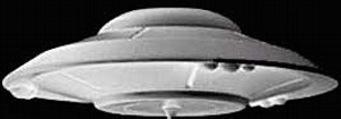
Why, then, is the myth so popular? A 1990 Gallup poll found a shocking 50% of the population “believing” in ESP and psychic “wonders,” compared to only 30% “believing” in ancient astronauts, or compared to only 7 to 4 % of the population “believing'' that pyramids or rock crystals have “special healing powers.” Yet consistently from 1970 to 1990, more than 90% of the population has heard or read about UFOs or flying saucers, 10 to 15% think they've seen one (one what is not clear), and an incredible 50 to 60% think UFOs are “something real,“ which is an extremely ambiguous diagnosis. The moon and Venus are indeed real. Polls up to 2003 have revealed similar figures— the number of believers hovers at 50% to 60% of the population!
Why do people believe so strongly in this myth that they'll look up while driving and see the moon high in the sky and report it as a flying saucer “hovering over and chasing my car,” an amazing incident that has happened a great many times? Back about 1986, a student in this pseudoscience class scolded me for spending several lectures on flying saucers. “Nobody is interested in that stuff anymore,” he said. But the very next year, three different flying saucer books were on the list of the top ten best-selling books, and remained on the list for quite a while. I was just as amazed as the student must have been. People never seem to wise up. The claims that have worked in the past are just retreaded over and over, and sent out again on a moneymaking orbit. Frank Scully's crashed saucers were thoroughly exposed as a hoax in a long criminal trial, but just three decades later Charles Berlitz retreaded Scully and made good money. The naive Space Brother claims, free saucer rides, and fakey saucer photos of George Adamski were laughed at by some of the same people who 40 years later thought Eduard (Billy) Meier's almost identical rides in flying saucers, plus nifty photos and secret space lore, just must be true! The wild but vaguely consistent 1966 nightmares of Betty Hill— kidnapped by aliens!— had by the late 1980s been reduced to the absurdity of the deliberately incoherent ramblings of Whitley Strieber, who at night was as likely to be carried off by elves, fairies, leprechauns, nixies, water sprites, tree elementals, or goblins as he was to be incessantly kidnapped by big-eyed Space Aliens. Evolving from the superficially plausible Fortean catalogues of “sightings” in the early 1950s, flying saucer literature has seemingly hit the rock bottom of complete absurdity, with no effect on book sales or levels of belief. No reduction to absurdity seems absurd enough for the True Believer. Why? Here's my guess.
Like the very popular astrology myth, the flying saucer myth bases its appeal on the simple fact that it makes us feel important. The stars and planets, huge objects far larger than the whole earth, separated by distances too vast to visualize... they overwhelm us. We're meaningless ants and gnats in the great universe out there. How comforting it is to cut the universe back down to size: it's just a toy, a clock on the wall that tells us when is a good day to ask the boss for a raise, sleep late, or avoid decisions. The whole universe is masked behind a shabby cardboard horoscope that lets us avoid responsibility for our actions and bask in blissful ignorance of everything known about not just astronomy, but also biology, genetics and physics. In the same way, the flying saucer myth tells us that “I am so important that all these space creatures just come here to spy on me. They fly over my house. Well, they fly over my town anyway. Well, maybe it's my county. Well, maybe it's not me, but they are in daily mental communication with George Adamski or maybe Daniel Fry or, uh, Truman Bethurum or, uh, Buck Nelson, no, I mean Betty Hill or Mrs. Keach or uh, George King or Billy Meier or somebody, somewhere!”
The myth does not make sense unless the earth is really at the center of the universe, the apple of the eyes of the gods. But we don't come right out and claim that, because that sounds old-fashioned and stupid. Instead, we say the earth is frequently visited by creatures from other worlds. Everybody knows that can happen; they saw it in movies and on TV. Gosh, in the 1950s movies were hardly about anything else but flying saucers landing on earth! You see, the Space People find us interesting! They find us important! They even look pretty much like us! They come here in hundreds, in thousands, in tens of thousands of totally different sorts of space ships, which strangely always seem to be in the earth's atmosphere instead of in outer space which is the only place they should work, but ignore that, that's a detail! They're fascinated by us! We're important somehow; we're wonderful, after all, just as we always thought. Maybe these creatures have a message for us, are here to save us, are here to take care of us somehow. Maybe they'll take us away with them someday and we won't have to worry about taxes and murders and wars and this month's rent and stuff! Maybe we won't have to suffer anymore and won't be unhappy all the time as we are now....
As far as the flying saucer myth is concerned, Copernicus and Galileo lived in vain. The flying saucers put us back where we “belong,” at the center of a small, neighborly, friendly universe, with God and his angels— or do we mean the Space Brothers? Or maybe the Grays?— right overhead with nothing better to do than stay ready to protect us. When this emotional appeal is added to the conceptual appeal of the tremendously exciting and completely familiar science fiction scenario of life on other worlds, and of alien spaceships coming to earth, it's hard to beat. As soon as you hear the spiel, no matter how absurd it is in any absolute sense, you have an immediate emotional stake in it being true. But the emotional appeal of the myth has had no effect on the cold facts. The earth is not, as far as anyone knows, being visited by creatures from other worlds. It is precisely when an idea has great emotional appeal that we are most likely to deceive ourselves concerning its truth or falsity, and to be satisfied with infantile rationalizations so transparent that most 8 year olds could debunk them if so motivated. In the famous words of the late Carl Sagan, “it is precisely the ideas with charm, the ideas that find deep emotional resonance within us, that have to be examined most critically. And don't forget, extraordinary claims require extraordinarily good evidence.'' Scientists would be overjoyed to see any evidence of any kind. They never get it. Instead they get only the supportless wild claims, dreary cliches, elementary fallacies and vacuous rhetoric of pseudoscience.
Let me tell a true story. I was in junior high school when the first great media wave of flying saucer hoopla swept past, in 1952. I was tremendously excited and bought many inexpensive books on the “phenomenon.” In parallel with this, I was also interested in astronomy, and the next year I got a 3-1/2 inch reflecting telescope, with which I spent many nights scanning the sky, looking for many happy hours at Jupiter and its moons, Saturn and its rings, Mars and its markings, the bright double stars, the bright nebulae, and the nearer galaxies. I subscribed to Sky and Telescope, the only magazine then aimed at amateur astronomers. It is strange how people compartmentalize things, especially beliefs that have no real connection with the facts of daily life. It was at least a year before I realized that my interest in flying saucers had never overlapped in any way with my interest in the night sky! It dawned on me: all of the “flying saucer sightings” in the books I read were made by people who knew nothing at all about what was normally over their heads. The one, fairly large group of people who did spend hours each clear night scanning the sky, by eyeball, by binocular, by telescope, and who knew intimately what was normally there to be seen, never reported “flying saucers” or UFOs. I wasn't seeing flying saucers. Venus and Jupiter and Mars were my old friends, and I knew my way around the moon a lot better than I knew my way around the city I lived in. When artificial satellites began to be launched I had no trouble spotting them instantly at dusk when angles were right. I and the other thousands of amateurs saw what was out there. It was notable that there were no UFOs. In my entire career I have still not encountered a single “UFO report” from an amateur astronomer. Amateur astronomy is still a very popular hobby, now with two large-circulation national magazines, Sky and Telescope and Astronomy. [It goes without saying that there are not any substantial UFO reports from professional astronomers either!]
The other thing that dawned on me, while I was still in high school, was that the saucer books never changed. The saucer books published in the early '50s were no different from the books published in the late '50s (or for that matter, the early '60s or the early '70s or the '80s or 90s or now). Later books had accounts of “new” sightings, but they were precisely as worthless and meaningless and filled with misrepresentation and omission as the old ones. New weird people got taken for unsubstantiated rides and founded their own weird cults based on the revelations they brought back. But nothing changed. Nothing progressed. No actual existing phenomenon was ever discussed. So already by 1955 the question in my 15-year-old mind was, why doesn't everyone notice this, sooner or later, about all pseudoscientific claims? I still don't know the answer to that question!
Another thing I noticed, as that last paragraph indicates, was that flying saucers were an easily exploitable, but very minor part of a semi-criminal subculture created almost exclusively by con-men, cult leaders and mental cases. Many of the books I collected “about flying saucers” actually found time to devote many chapters to Atlantis, Theosophy, psychic powers, ancient astronauts, dowsing, Creationism, crystals, even crackpot “theories” of the atom, and just about all the other aspects of pseudoscience we're dealing with in this class. Indeed, the books in my little collection formed a very clear evolutionary sequence from superficially plausible Fortean catalogues to wild-eyed neoTheosophist absurdity, interspersed with ignorant diatribes against science and scientists. The net was down. The concept was for sale, not for inspiration. So flying saucers were, alas, never part of the real world we live in, but rather almost instantly became a fairly unimportant theme in the webs of a fantasy subworld that street-wise dropouts used cynically to exploit other dropouts and losers.
My flying saucer books became the nucleus of a modest collection of books on and about pseudoscience which I added to as modest finances permitted all through the 1960s and 70s... and ultimately led to the course you are taking now.
I still sometimes miss those saucers, in a way. So far, there is no possibility of avoiding the cold, hard fact that the actual history of UFOs since 1947 is entirely a depressing history of human self-deception, punctuated by the emergence of theme-setting con-men, and some genuine crazies. An actual visit to our humble planet by intelligent beings from another world would be perhaps the most important event in the entire history of mankind so far. While it may be sad to see so high a concept dragged into the muck of pseudoscience, be aware of the usual fate of high concepts that find no correspondence with the real universe we live in. Pseudoscience provides the only soil in which they can survive.
For further reading—
Links---
 |
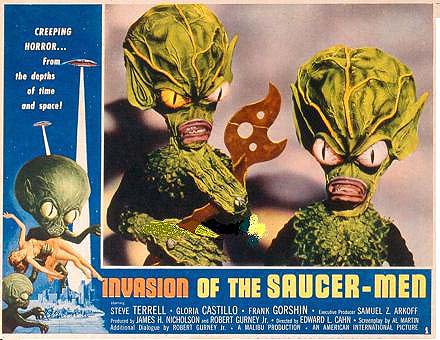 |
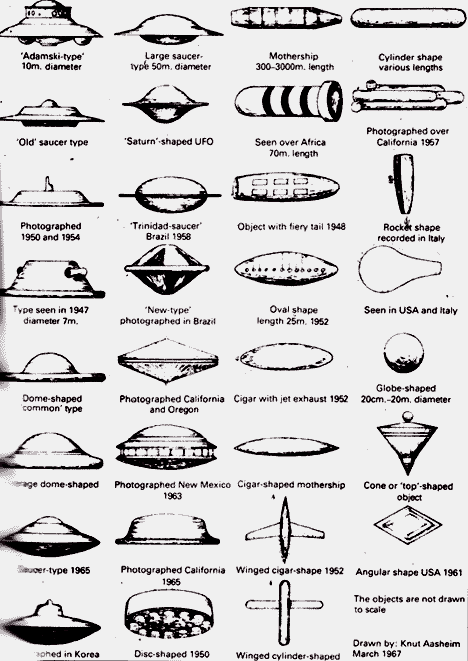 |
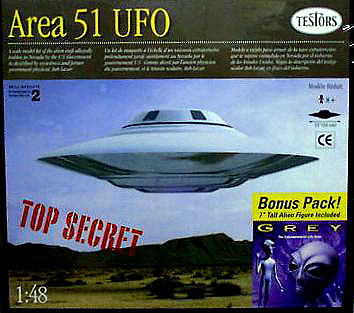 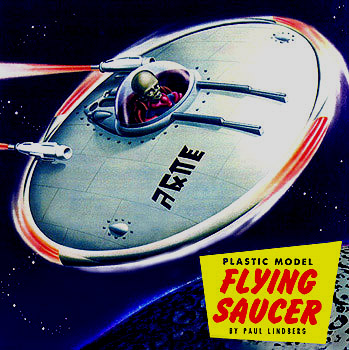 |